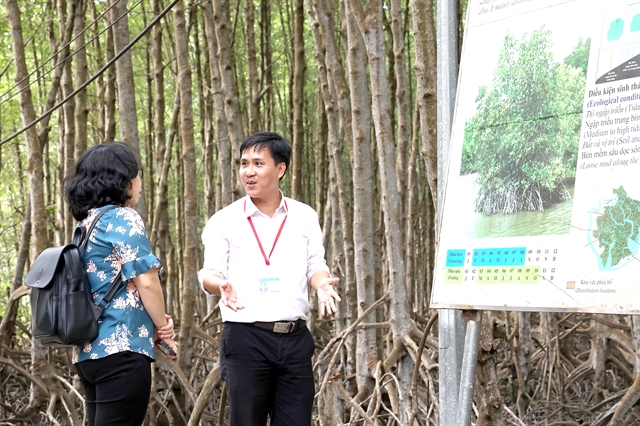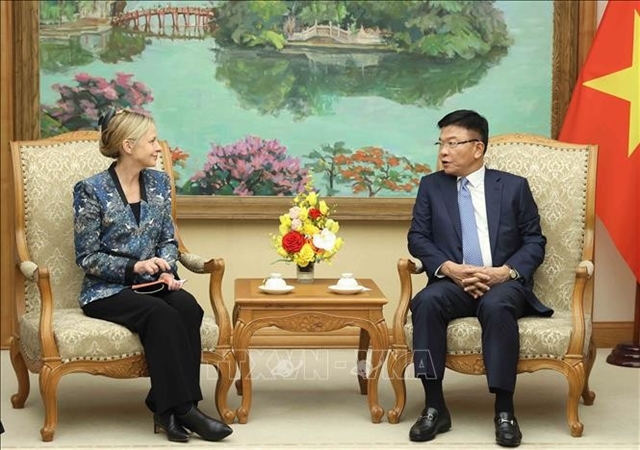 Environment
Environment

 |
| With many unique values, the Cần Giờ Island mangrove forest became Việt Nam’s first Biosphere Reserve recognised by UNESCO in 2000. —VNA/VNS Photos |
HÀ NỘI — As a coastal locality of HCM City, Cần Giờ Island features a mangrove forest that thrives on the alluvial soil brought by the Sài Gòn and Đồng Nai rivers, combined with the tropical monsoon climate, a semi-diurnal tidal cycle, and a dense network of rivers and canals.
With many unique values, the Cần Giờ Island mangrove forest became Việt Nam's first Biosphere Reserve recognised by UNESCO in 2000. Assessments have revealed a high level of biodiversity, rich in both quantity and species, and home to the largest and most beautiful concentrated mangrove forest in Southeast Asia.
This is a remarkable rebirth, as during the years of war, this area suffered from millions of litres of chemical agents, thousands of tonnes of bombs and shells, transforming vast forests into barren and arid land. The resources of fauna, flora, and marine life were nearly destroyed, and the ecological environment was severely polluted.
After nearly 50 years of restoration, protection, and development (since 1978), the Cần Giờ mangrove ecosystem has been fully restored and is recognised by experts and scientists as a rapidly recovering mangrove forest on a large scale, primarily through human efforts. It is considered a "green carbon reservoir" and a "green lung" that forms a solid "green wall" protecting the environment for HCM City and neighbouring areas.
Green tourism linked with indigenous culture conservation
Cần Giờ holds great potential with numerous ecological tourism destinations, including forests and beaches, as well as historical and cultural sites. Recently, a new model has emerged, showing a revitalising shift toward community-based tourism in association with protecting the environment, the mangrove ecosystem, traditional crafts, and indigenous culture in Thiềng Liềng hamlet, Thạnh An Island commune.
The fresh air, the picturesque landscape, and the vibrant green of the mangrove forest, combined with the simple, pristine charm of the small island, are creating a unique appeal for this destination.
In 2024, Cần Giờ attracted nearly 4.4 million visitors, and earned nearly VNĐ3.5 trillion (US$136.8 million) in tourism revenue, marking a 23 per cent increase compared to 2023. The number of visitors to the mangrove forest has been steadily rising, helping to create jobs and improve income for those working in forestry, tourism services, aquaculture and fishing, and production under the forest canopy, while also boosting the local budget.
 |
| A local resident contracted to protect the forest. |
Green solutions for the future
The vision for Cần Giờ development is outlined in Resolution No. 12-NQ/TU by the HCM City Party Committee’s Standing Board, which identifies that the economic development must be linked with the sustainable protection of the world biosphere reserve. It aims to make the district a model of harmony between the conservation of biodiversity and natural ecosystems, the improvement of the community's quality of life, the preservation of traditional cultural values, and the promotion of green, sustainable economic growth.
Prime Minister Phạm Minh Chính once emphasised that with its mangrove ecosystem and Cần Giờ Biosphere Reserve, HCM City must plan to develop Cần Giờ into a “city in the forest” by 2030.
The city’s leaders have also long expected Cần Giờ to be a pioneering locality in the city for achieving the "net zero" goal by 2035, 15 years ahead of Việt Nam’s international commitment. To achieve this goal, the city is focusing on investments in areas such as converting waste into electricity to meet production and living needs, creating a plastic-free destination, developing green tourism, and piloting carbon credits with the Cần Giờ forest.
HCM City intends to develop and implement a plan to nominate the Cần Giờ Coastal Wetland as a Wetland of International Importance (Ramsar site) to preserve its marine and coastal ecosystems. The city will also effectively implement climate change adaptation programmes, combat coastal erosion, flooding, and saltwater intrusion based on the application of advanced science and technology. In particular, smart models capable of adapting to and withstanding natural disasters will be applied.
At the same time, the city is building mechanisms and policies to attract scientists, businesses, and local communities to participate and collaborate with local authorities in the management, conservation, restoration, and development of mangrove forests, in order to fully realise the role and value of the Biosphere Reserve according to the criteria set by the National Committee for the Man and the Biosphere Programme (MAB) of UNESCO.
 |
| Monkey Island is a famous and unique destination, serving as a signature tourism attraction in Cần Giờ. |
Regarding the Cần Giờ International Transshipment Port project, based on preliminary environmental impact assessments, the municipal People's Committee stated that the project lies within the buffer zone of the Cần Giờ Mangrove Biosphere Reserve. According to the regulations on biosphere reserve management, the area is allowed to carry out economic development activities, provided that the structures and materials used harmonise with the natural landscape and are approved by the competent authorities.
Furthermore, the project will be designed to have more than 10 per cent of the area designated for the conservation of protective forests and green spaces, ensuring a balance between economic development and environmental protection. — VNS




